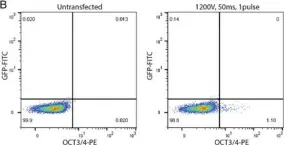Dutch-type cerebral amyloid angiopathy (D-CAA), also known as hereditary cerebral haemorrhage with amyloidosis-Dutch type (HCHWA-D), is an autosomal dominant disorder caused by a G to C transversion in codon 693 of the amyloid precursor protein (APP) that results in a Gln-to-Glu amino acid substitution. CRISPR-Cas9 editing was used for genetic correction of the mutation in a human induced pluripotent stem cell (hiPSC-) line established previously. The isogenic hiPSCs generated showed typical pluripotent stem cell morphology, expressed all markers of undifferentiated state, displayed a normal karyotype and had the capacity to differentiate into the three germ layers.
Copyright © 2023 The Author(s). Published by Elsevier B.V. All rights reserved.
Product Citations: 9
In Stem Cell Research on 1 September 2023 by Nahon, D. M., Ganesh, S., et al.
-
Homo sapiens (Human)
-
Genetics
-
Stem Cells and Developmental Biology
In Stem Cell Research on 1 March 2023 by Arendzen, C. H., Cramer, S. J., et al.
We previously generated a doxycycline-inducible H2B-mTurq2 reporter in hiPSCs to track cells and study cell division and apoptosis. To improve visualization of cycling cells, we introduced a ubiquitously transcribed mScarletI-Geminin (GMMN) (1-110) into the previously untargeted second AAVS1 allele. Fusion to the N-terminal part of GMNN provided tightly controlled mScarletI expression during the cell cycle. mScarletI fluorescence increased gradually from the S-phase through the M-phase of the cell cycle and was lost at the metaphase-anaphase transition. The resulting hiPSC reporter line generated, which we named ProLiving, is a valuable tool to study cell division and cell cycle characteristics in living hiPSC-derived cells.
Copyright © 2023 The Authors. Published by Elsevier B.V. All rights reserved.
-
Homo sapiens (Human)
-
Stem Cells and Developmental Biology
Generation of AAVS1 and CLYBL STRAIGHT-IN v2 acceptor human iPSC lines for integrating DNA payloads.
In Stem Cell Research on 1 February 2023 by Blanch-Asensio, A., van der Vaart, B., et al.
STRAIGHT-IN is a platform to precisely integrate DNA payloads into the genome of cells, including hiPSCs. Here, we generated two hiPSC acceptor lines each with one copy of an upgraded landing pad (LP). This improved design allows more efficient (∼100 %) and rapid (∼2-3 weeks) generation of genetically modified hiPSC lines containing the desired payloads. This new LP version was inserted into either the AAVS1 (LUMCi004-A-1) or CLYBL (LUMCi004-A-2) safe harbour loci in the hiPSC line, LUMC0099iCTRL04. The resulting lines can be used for the targeted integration of a wide range of transgenes, thereby making them suitable for numerous research applications.
Copyright © 2022 The Authors. Published by Elsevier B.V. All rights reserved.
-
Homo sapiens (Human)
-
Genetics
-
Stem Cells and Developmental Biology
In Frontiers in Physiology on 8 January 2022 by van den Brink, L., Brandão, K. O., et al.
While rare mutations in ion channel genes are primarily responsible for inherited cardiac arrhythmias, common genetic variants are also an important contributor to the clinical heterogeneity observed among mutation carriers. The common single nucleotide polymorphism (SNP) KCNH2-K897T is associated with QT interval duration, but its influence on the disease phenotype in patients with long QT syndrome type 2 (LQT2) remains unclear. Human induced pluripotent stem cells (hiPSCs), coupled with advances in gene editing technologies, are proving an invaluable tool for modeling cardiac genetic diseases and identifying variants responsible for variability in disease expressivity. In this study, we have used isogenic hiPSC-derived cardiomyocytes (hiPSC-CMs) to establish the functional consequences of having the KCNH2-K897T SNP in cis- or trans-orientation with LQT2-causing missense variants either within the pore-loop domain (KCNH2A561T/WT) or tail region (KCNH2N996I/WT) of the potassium ion channel, human ether-a-go-go-related gene (hERG). When KCNH2-K897T was on the same allele (cis) as the primary mutation, the hERG channel in hiPSC-CMs exhibited faster activation and deactivation kinetics compared to their trans-oriented counterparts. Consistent with this, hiPSC-CMs with KCNH2-K897T in cis orientation had longer action and field potential durations. Furthermore, there was an increased occurrence of arrhythmic events upon pharmacological blocking of hERG. Collectively, these results indicate that the common polymorphism KCNH2-K897T differs in its influence on LQT2-causing KCNH2 mutations depending on whether it is present in cis or trans. This study corroborates hiPSC-CMs as a powerful platform to investigate the modifying effects of common genetic variants on inherited cardiac arrhythmias and aids in unraveling their contribution to the variable expressivity of these diseases.
Copyright © 2021 van den Brink, Brandão, Yiangou, Blanch-Asensio, Mol, Mummery, Verkerk and Davis.
-
FC/FACS
-
Homo sapiens (Human)
-
Endocrinology and Physiology
In Stem Cell Research on 1 December 2021 by Arendzen, C. H., Chaudhari, U., et al.
An induced pluripotent stem cell (iPSC) line, in which a H2B-fluorescent protein fusion is temporally expressed, is a valuable tool to track cells and study cell divisions and apoptosis. To this end we introduced a 3rd generation "all-in-one" doxycycline-inducible H2B-mTurquoise2 vector into the AAVS1 locus of PAX3-Venus iPSCs via CRISPR/Cas9. H2B-mTurquoise2 expression is absent but readily induced by doxycycline allowing quantification of cell divisions and imaging of living cells. Besides being a universal reporter in iPSC-based differentiation and toxicity assays, the generated pluripotent and genomically normal LUMCi041-A-2 line is particularly suited to study PAX3-positive stages of development.
Copyright © 2021 The Authors. Published by Elsevier B.V. All rights reserved.
-
Homo sapiens (Human)
-
Stem Cells and Developmental Biology
In Curr Protoc Stem Cell Biol on 1 December 2020 by Bouma, M. J., Arendzen, C. H., et al.
Fig.2.B

-
FC/FACS
-
Collected and cropped from Curr Protoc Stem Cell Biol by CiteAb, provided under a CC-BY license
Image 1 of 1
